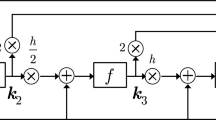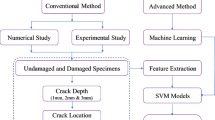Abstract
In this paper, a new online damage detection method is developed using displacement and velocity measurements of the structure. The proposed method is an improved synchronization-based approach in which any changes in system parameters can be measured by synchronizing a mathematical model with the real model of the structure in real time. Several damage scenarios for structures subjected to different seismic ground motion acceleration records are studied to validate the effectiveness of the proposed method. The effect of noise on the performance of the proposed algorithm is also investigated and discussed. Numerical results demonstrate that the proposed technique has the capability of tracking the abrupt changes of stiffness and damping parameters with high accuracy in real time.















Similar content being viewed by others
References
Yang JN, Lin S, Huang H, Zhou L (2006) An adaptive extended Kalman filter for structural damage identification. Struct Control Health Monit 13:849–867
Amini F, Mohajeri SA, Javanbakht M (2015) Semi-active control of isolated and damaged structures using online damage detection. Smart Mater Struct 24:105002
He J, Huang Q, Xu Y-L (2014) Synthesis of vibration control and health monitoring of building structures under unknown excitation. Smart Mater Struct 23:105025
He J, Xu Y-L, Zhan S, Huang Q (2017) Structural control and health monitoring of building structures with unknown ground excitations: experimental investigation. J Sound Vib 390:23–38
Karami K, Akbarabadi S (2016) Developing a smart structure using integrated subspace-based damage detection and semi-active control. Comput-Aided Civ Infrastruct Eng 31:887–903
Karami K, Amini F (2012) Decreasing the damage in smart structures using integrated online DDA/ISMP and semi-active control. Smart Mater Struct 21:105017
Xu Y, Chen B (2008) Integrated vibration control and health monitoring of building structures using semi-active friction dampers: part I—methodology. Eng Struct 30:1789–1801
Mousavi M, Gandomi AH (2016) A hybrid damage detection method using dynamic-reduction transformation matrix and modal force error. Eng Struct 111:425–434
Lee E-T, Eun H-C (2019) Model-based damage detection using constraint forces at measurements. Eng Comput. https://doi.org/10.1007/s00366-019-00762-9
Lee E-T, Eun H-C (2015) Damage identification of a frame structure model based on the response variation depending on additional mass. Eng Comput 31:737–747
Rahai A, Bakhtiari-Nejad F, Esfandiari A (2007) Damage assessment of structure using incomplete measured mode shapes. Struct Control Health Monit 14:808–829
Weber B, Paultre P, Proulx J (2007) Structural damage detection using nonlinear parameter identification with Tikhonov regularization. Struct Control Health Monit 14:406–427
Yang Z, Wang L (2010) Structural damage detection by changes in natural frequencies. J Intell Mater Syst Struct 21:309–319
Zhu H, Li L, He X-Q (2011) Damage detection method for shear buildings using the changes in the first mode shape slopes. Comput Struct 89:733–743
Jin C, Jang S, Sun X (2015) Structural damage detection using extended Kalman filter combined with statistical process control. In: Sensors and smart structures technologies for civil, mechanical, and aerospace systems 2015. International Society for Optics and Photonics, 2015, pp 94352 K
Concha A, Garrido R, Alvarez-Icaza L (2016) Identification of shear buildings using an instrumental variable method and linear integral filters. J Sound Vib 385:149–170
Frigui F, Faye J, Martin C, Dalverny O, Peres F, Judenherc S (2018) Global methodology for damage detection and localization in civil engineering structures. Eng Struct 171:686–695
Lei Y, Jiang Y, Xu Z (2012) Structural damage detection with limited input and output measurement signals. Mech Syst Signal Process 28:229–243
Lin JW, Betti R, Smyth AW, Longman RW (2001) Online identification of non-linear hysteretic structural systems using a variable trace approach. Earthq Eng Struct Dyn 30:1279–1303
Yang JN, Huang H (2007) Sequential non-linear least-square estimation for damage identification of structures with unknown inputs and unknown outputs. Int J Non-Linear Mech 42:789–801
Yang JN, Pan S, Huang H (2007) An adaptive extended Kalman filter for structural damage identifications II: unknown inputs. Struct Control Health Monit 14:497–521
Ramirez JP, Fey RHB (2013) Nijmeijer H (2013) Synchronization of weakly nonlinear oscillators with Huygens’ coupling. Chaos Interdiscip J Nonlinear Sci 23:033118
Peña-Ramírez J, RHB F, Nijmeijer H (2012) An experimental study on synchronization of nonlinear oscillators with Huygens’ coupling. Nonlinear Theory Appl IEICE 3:128–142
Boccaletti S, Kurths J, Osipov G, Valladares D, Zhou C (2002) The synchronization of chaotic systems. Phys Rep 366:1–101
Pecora LM, Carroll TL (1990) Synchronization in chaotic systems. Phys Rev Lett 64:821–824
Boeing G (2016) Visual analysis of nonlinear dynamical systems: chaos, fractals, self-similarity and the limits of prediction. Systems 4:37
Kellert SH (1993) In the wake of chaos: unpredictable order in dynamical systems. University of Chicago Press, Chicago
Parlitz U (1996) Estimating model parameters from time series by autosynchronization. Phys Rev Lett 76:1232
Parlitz U, Junge L, Kocarev L (1996) Synchronization-based parameter estimation from time series. Phys Rev E 54:6253–6259
Blekhman I, Landa PS, Rosenblum MG (1995) Synchronization and chaotization in interacting dynamical systems. Appl Mech Rev 48:733–752
Kapitaniak T (1994) Synchronization of chaos using continuous control. Phys Rev E 50:1642
Rosenblum MG, Pikovsky AS, Kurths J (1996) Phase synchronization of chaotic oscillators. Phys Rev Lett 76:1804
Rosenblum MG, Pikovsky AS, Kurths J (1997) From phase to lag synchronization in coupled chaotic oscillators. Phys Rev Lett 78:4193
Ghaderi P, Amini F (2019) A new method for online identification of civil structures: virtual synchronization. Int J Adapt Control Signal Process 33:16–38
Author information
Authors and Affiliations
Corresponding author
Additional information
Publisher's Note
Springer Nature remains neutral with regard to jurisdictional claims in published maps and institutional affiliations.
Rights and permissions
About this article
Cite this article
Amini, F., Moradmand, M. Improved synchronization-based approach for online damage detection of civil structures. Engineering with Computers 38, 1337–1349 (2022). https://doi.org/10.1007/s00366-020-01051-6
Received:
Accepted:
Published:
Issue Date:
DOI: https://doi.org/10.1007/s00366-020-01051-6




